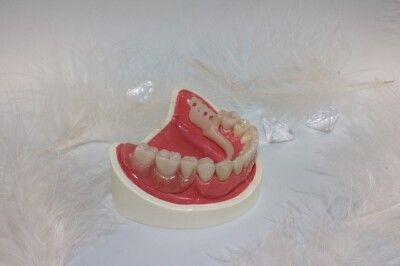Bridges, crowns, implants: These are the differences in dental prosthetics
A beautiful smile and healthy teeth are an important ideal of beauty in modern society. However, many people suffer from bad teeth or have already lost some teeth.
In order not to be discriminated against in everyday life and to finally be able to feel good about themselves again when they look in the mirror, many affected people opt for dental prostheses.
Different options for dental prostheses
Depending on how large the gap in the row of teeth is, various options for tooth replacement come into question. For gaps that are not too large, fixed dentures such as crowns or bridges are usually used.
If the gaps are larger, however, removable dentures in the form of prostheses are used. The following article explains in detail what options are available with regard to tooth replacement.
The implants
Implants are artificial tooth roots, which are fixed in the upper or lower jaw by metal pins.
In fact, it is not an artificial tooth, because the final prosthesis – denture, bridge or crown – is only attached to the implant.
Implants have the advantage that the healthy neighboring teeth do not have to be ground down. Nevertheless, it is a surgical procedure that is always associated with certain health risks.
Therefore, with this method it is especially important to rely on an experienced and competent doctor, such as the implantologist Dr. Andreas Allgöwer, to place.
In the field of dental prosthesis, implants are the most expensive option. Implants are not included in the standard care of the statutory health insurance, which means that they are billed entirely privately.
In exceptional cases, however, implants may be covered by health insurance if there are particularly severe defects of the jaw or face, for example in the case of congenital malformations or tumor diseases.
The crowns
If there is so much damage to a tooth that a filling can no longer be used, a dental crown comes into question. This is made after an impression in the laboratory and then cemented to the tooth.
There are three different types of crowns. In the posterior region, the statutory health insurance provides a metallic full crown, which is made of non-metal. The costs for this service are usually covered by health insurance companies up to 50 percent.
The all-ceramic crown most closely resembles the appearance of a real tooth. Although this is not as durable as the metal crown, it is still very well tolerated.
In addition, there is also the option of a metal veneer crown. In this case, the metal framework is partially or completely covered with plastic or ceramic in the color of the tooth.
A tooth-colored veneer is paid for by health insurance companies if the crowning of an anterior tooth is necessary.
The bridges
The material for dental bridges can be ceramic, metal or plastic veneer. However, ceramic bridges are less durable and stable than metal bridges, which is why they are not covered by public health insurance.
Bridges are accepted by the statutory health insurance as a solution if a maximum of two teeth are missing next to each other. If more teeth are missing, a partial denture is subsidized in the posterior region, which is removable.
In the case of a bridge, the neighboring teeth act as a so-called anchor. Therefore, they must be ground and crowned, which creates the risk of damage to the dental nerve. A distinction is made between end abutment, free-end and adhesive bridges.
In the latter case, the bridges are only glued, which can be considered as a temporary solution or for small gaps between teeth. The metal framework is fixed to the back of the neighboring teeth with thin adhesive plates.
However, the so-called end-pillar bridge is most frequently used. This type of dental bridge is attached to the remaining teeth on the left and right side.
If a tooth is missing on one side as a pontic, for example at the end of the tooth row, it is not possible to fix the bridge on two sides. This is then called a free-end bridge.
Dentures
If too many teeth have already been lost, dentures serve to allow the affected person to continue to have the appearance of a closed row of teeth. If so many teeth are missing that it is no longer possible to anchor a bridge, partial dentures are used.
Depending on which connecting elements are used, the denture is referred to as a bar, attachment or telescopic denture. A model cast denture represents the simplest variant of the denture.
This is fixed to the remaining teeth with clasps, which are quite visible. This means that it is not necessary to crown the anchor teeth.
On the other hand, full dentures are fixed by an adhesive, bonding or suction effect. This is necessary if there are no more natural teeth in the lower or upper jaw.
The standard treatment for a partial denture, including the fixed allowance, costs approximately 670 euros. The cost of a full denture is about 600 euros.
The fixed denture is generally considered the more recommendable solution. Compared to the dentures, the comfort for the patient is much higher, also the aesthetics and durability are better.
The risk of caries and gum damage is also lower. However, the cost of the prostheses is lower than for the fixed variants of the denture.








